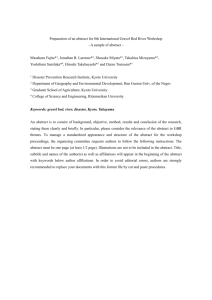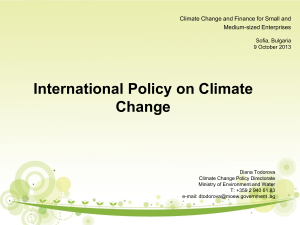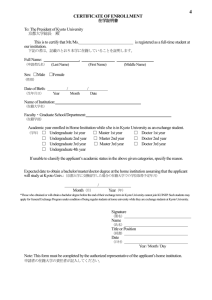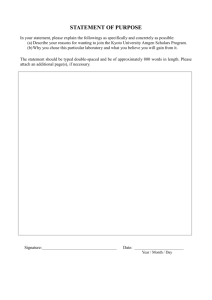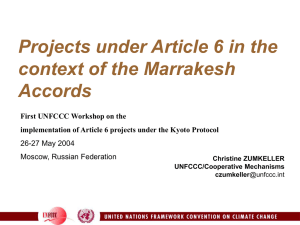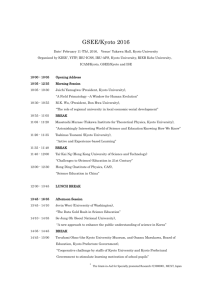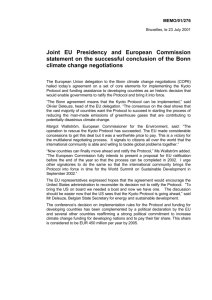The Kyoto Protocol: fundamentals and responses
advertisement
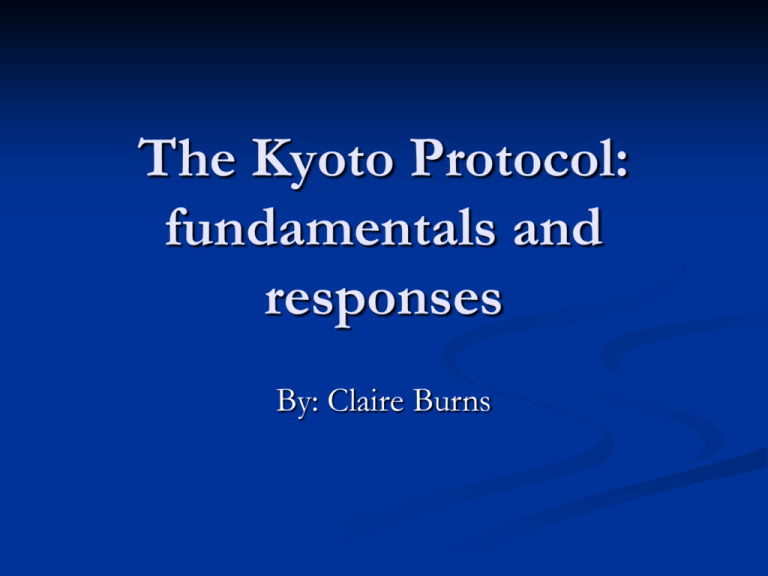
The Kyoto Protocol: fundamentals and responses By: Claire Burns The Treaty Negotiated in 1997 in Kyoto Japan Came into force February 16th, 2005 Definition: “A legally binding agreement under which industrialized countries will reduce their collective emissions of greenhouse gases by 5.2% compared to the year 1990” * (left) staffwww.fullcoll.edu (right) media-2.web.britannica.com Notes (Slide 1) Go over the dates (negotiated in 1997 and took action in 2005) The treaty was defined in the text of the Kyoto Protocol according to Kyotoprotocol.com as “A legally binding agreement under which industrialized countries will reduce their collective emissions of greenhouse gases by 5.2% compared to the year 1990”– National target ranges were scattered, with 8% reductions for the European Union, 7% for the US, 6% for Japan, 0% for Russia AND permitted increases of 8% for Australia and 10% for Iceland The goal according to the treaty was to: lower overall emissions from six greenhouse gases- carbon dioxide, methane, nitrous oxide, sulfur hexafluoride, HFCs and PFCs. Distinction: While the convention encouraged industrialized countries to stabilize their GHG emissions, the protocol commits them Sources: *United Nations Environmental Programme, Text of the Kyoto Protocol—available at this web page: http://www.kyotoprotocol.com/ *Fullerton College, Environmental Science Department, The Japan Times headline, 2009. http://staffwww.fullcoll.edu/tmorris/an_inconvenient_truth/kyoto_protocol_newspaper.jpg *Encyclopedia Britannica, Conference in Kyoto Japan, 1997. http://media-2.web.britannica.com/eb-media/35/91935-004-9B371887.jpg * “Kyoto Protocol,” UNFCC http://unfccc.int/kyoto_protocol/items/2830.php Kyoto Mechanisms The Kyoto Protocol allows countries an additional set of options to meet their targets through 3 mechanisms: Emissions Trading— Article 17 Clean Development Mechanism—Article 12 Joint Implementation— Article 6 Comic referring to Emissions Trading http://gmarkets.files.wordpress.com/2007/10/carb on_credit1.gif Notes (Slide 2) Introduce the idea of the Kyoto Mechanisms Describe Emissions trading and point out comic—It allows countries who have unused emission units, to sell the units to countries that are over their targets Describe Clean Development Mechanism—allows countries who are under a limitation agreement with the Kyoto Protocol to set up what is called a “emissionreduction project” in developing countries, which would award that country certified emissions reduction (CER) credits to go toward meeting Kyoto targets Describe Joint Implementation—allows countries who are under a limitation agreement with the Kyoto Protocol to earn Emission Reduction Units (ERUs) from an emission reduction or removal program in another country, which also can be applied toward reaching that country’s Kyoto target Sources: * “The Mechanisms under the Kyoto Protocol,” UNFCC http://unfccc.int/kyoto_protocol/mechanisms/joint_implementation/items/1674.php * Green Markets, Emissions Trading comic, 2007. http://gmarkets.files.wordpress.com/2007/10/carbon_credit1.gif Country Involvement •Note that the United States is the only country that refused ratification http://www.safecoast.org/editor/databank/Image/800pxKyoto_Protocol_participation_map_2005.png • But also that although big emitters like China and India have signed on, they do not have to begin making cuts until 2012 Notes (Slide 3) United States is only country that signed, yet neglected to ratify—I will go into more detail why they did not find the Protocol suitable It is important to realize that the image can be slightly misleading, since certain countries may have adopted the Kyoto Protocol but do not have to act until 2012. For example India and China—although some of the World’s fastest growing emitters— are considered developing countries with serious issues, and thus have a pass on the first Kyoto round As of February, 2009, 181 states have signed and ratified Sources: * “List of Kyoto Protocol Signatories,” Wikipedia, Wikimedia Foundation Inc. http://en.wikipedia.org/wiki/List_of_Kyoto_Protocol_signatories * “Kyoto Protocol,” Safecoast.org. http://www.safecoast.org/editor/databank/Image/800pxKyoto_Protocol_participation_map_2005.png * “Kyoto and Beyond,” CBC News, 14 Feb. 2007. http://www.cbc.ca/news/background/kyoto/ Why the US says no “The goals of the Kyoto Protocol were established not by science, but by political negotiation, and are therefore arbitrary and ineffective in nature. In addition, many countries of the world are completely exempted from the Protocol, such as China and India, who are two of the top five emitters of greenhouse gasses in the world. Further, the Protocol could have potentially significant repercussions for the global economy.” –United States Policy on the Kyoto Protocol (Fact Sheet) Greenhouse gas emissions by country (2000) Notes (Slide 4) Read quotation explaining US resistance in response to China and India’s exemption On March 29, 2001, The Bush administration withdrew US from Kyoto Protocol President Bush responded by establishing a working group to find “a more practical method” to face the problem—Clear Skies and Global Climate Change Initiatives These methods commit America to cut greenhouse gas intensity by 18% in the next ten years (as of 2002) Intended to have same product of Kyoto Protocol but using “market-based approaches” Focus of initiatives: Ensuring continuing economic growth Finding “truly global” solutions Utilizing the most modern technology Focusing on bilateral relations to provide assistance, especially in the Western Hemisphere Sources: • “Fact Sheet: United States Policy on the Kyoto Protocol,” Public Affairs Section. US embassy http://vienna.usembassy.gov/en/download/pdf/kyoto.pdf • “List of Countries by greenhouse gas emissions per capita,” Wikipedia. Wikimedia Foundation, Inc. http://en.wikipedia.org/wiki/List_of_countries_by_greenhouse_gas_emissions_per_capita Additional Responses to Kyoto “…as an instrument for achieving emissions reductions, it has failed. It has produced no demonstrable reductions in emissions or even in anticipated emissions growth.” “But the rational thing to do in the face of a bad investment is to cut your losses and try something different.” – Gwyn Prins and Steve Rayner in “Time to ditch Kyoto” “There were two fundamental problems: one inherent in the negotiating model and the other in the issue structure that came to dominate the process. The first overestimated the possibility that science would counter the divergent interests of different states sufficiently for them to act in the greater global good; the second diminished the possibility that force of moral obligation would enhance this prospect.” --Aynsley Kellow “Kyoto: talks must include key aspects of science” Notes (Slide 5) Go over quotations, rather self explanatory, just further analysis of why Kyoto Protocol has not sufficiently attacked the problem of global warming according to Gwyn Prins and Steve Rayner in “Time to ditch Kyoto” and Aynsley Kellow in response with “Kyoto: talks must include key aspects of science” Sources: Prins and Rayner, 2007, Time to ditch Kyoto, Nature, 449, 973-975 Kellow, Aynsley, 2007, Kyoto: talks must include key aspects of science
